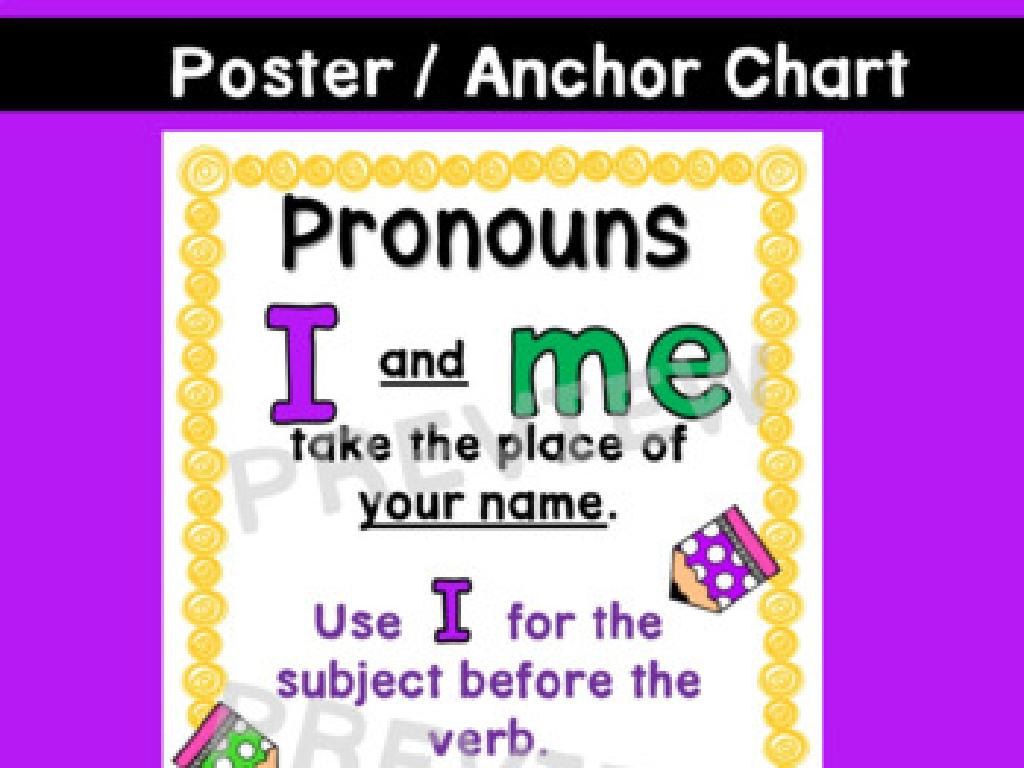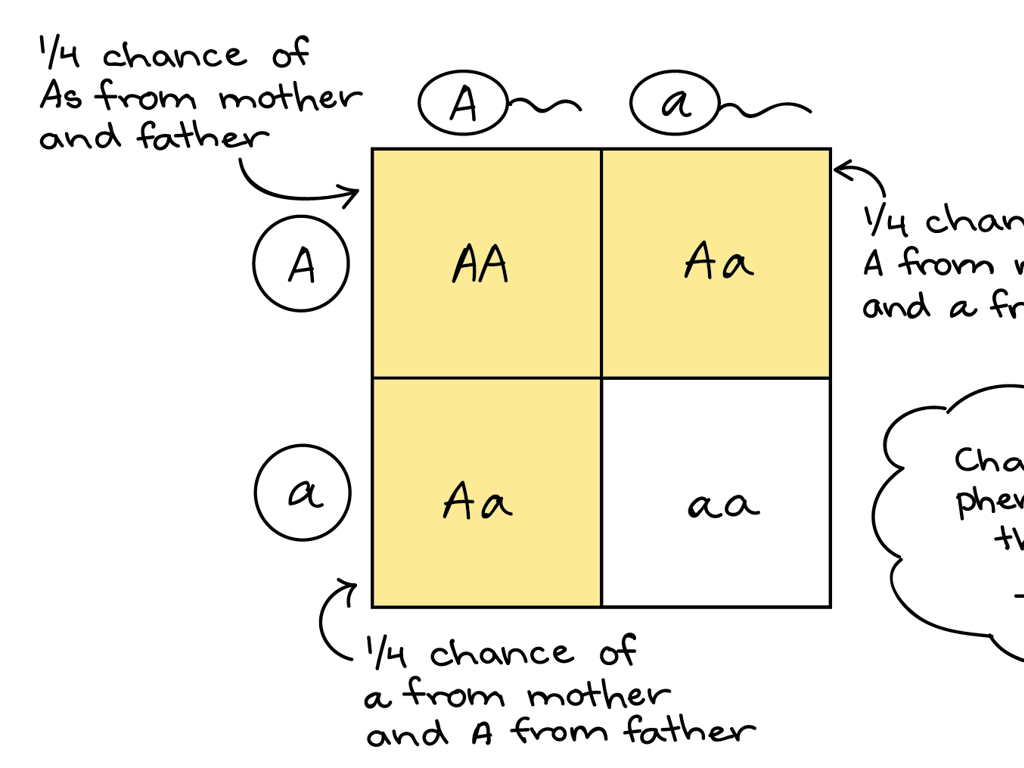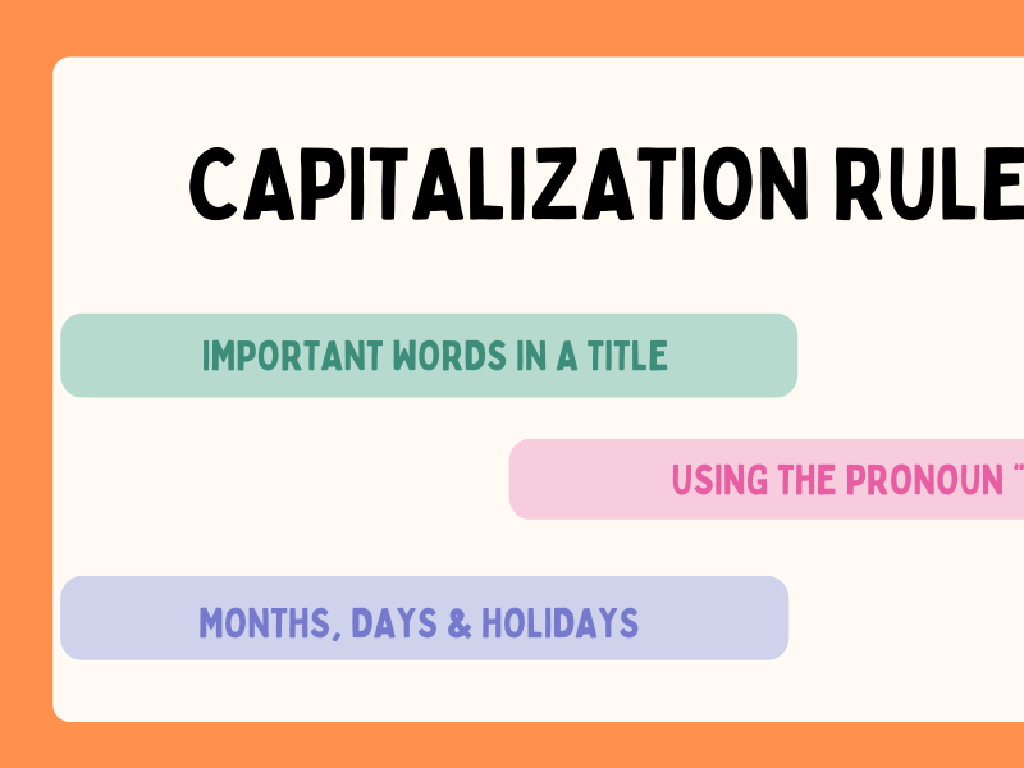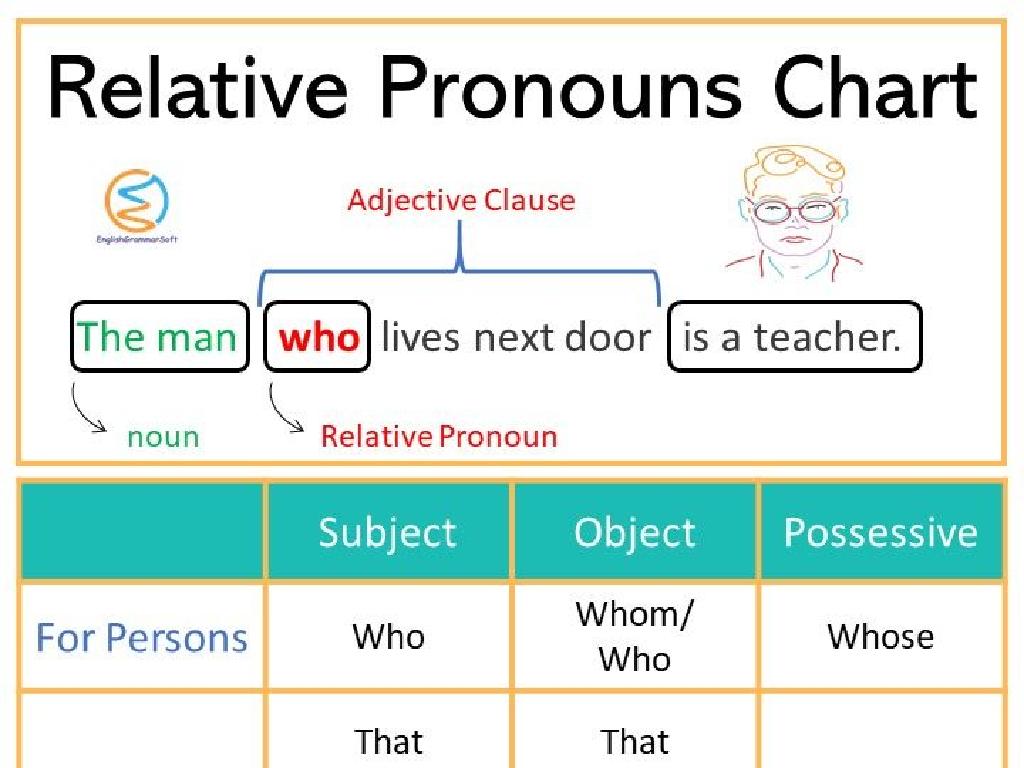Similar And Congruent Figures
Subject: Math
Grade: Eighth grade
Topic: Transformations And Congruence
Please LOG IN to download the presentation. Access is available to registered users only.
View More Content
Exploring Similarity and Congruence
– Define similarity and congruence
– Similar figures have the same shape but different sizes, while congruent figures are identical in shape and size.
– Relate to everyday objects
– Consider the shapes of doors, windows, or even phone screens for real-world examples of these concepts.
– Explore similar and congruent figures
– We’ll examine how figures can be similar or congruent through transformations like rotation, reflection, and translation.
– Preview of transformation applications
|
This slide introduces the foundational concepts of similarity and congruence, which are crucial in understanding geometric relationships. Begin by defining similarity as having the same shape but not necessarily the same size, and congruence as being identical in both shape and size. Use everyday objects to illustrate these concepts, making them more accessible and relatable to students. The lesson will delve into how geometric transformations can result in similar or congruent figures, setting the stage for practical applications of these concepts. Encourage students to think of examples from their surroundings to foster engagement and curiosity.
Exploring Congruent Figures
– Define congruent figures
– Figures identical in shape and size, like two identical triangles
– Real-life congruent examples
– Identical twins, same model cars, or matching socks
– Properties of congruence
– They have equal corresponding angles and sides
– Congruence in geometric transformations
– Congruence is maintained through rotation, reflection, and translation
|
This slide introduces the concept of congruent figures, which are figures that are exactly the same in shape and size. Use everyday examples to help students relate to the concept, such as pairs of identical objects they encounter daily. Discuss the properties that define congruent figures, emphasizing that all corresponding angles and sides of congruent figures are equal. Highlight how congruent figures remain congruent even after geometric transformations like rotation, reflection, and translation, which do not alter their size or shape. Encourage students to visualize these transformations and consider how congruence is an essential aspect of symmetry in both geometry and the world around them.
Exploring Similar Figures
– Define similar figures
– Figures with the same shape but different sizes
– Explore scale factor
– Scale factor is the ratio of the lengths of corresponding sides
– Discuss properties of similarity
– Corresponding angles are equal; sides are proportional
– Examples of similar figures
– Consider triangles on a playground or matryoshka dolls
|
This slide introduces the concept of similar figures, which are essential in understanding geometric relationships. Start by defining similar figures as shapes that have the same form but may differ in size. Explain that the scale factor is a crucial concept that relates the sizes of two similar figures. Emphasize that in similar figures, while the angles remain the same, the side lengths are scaled by a constant factor, the scale factor. Provide real-world examples such as similar triangles found in playground equipment or the concept of scaling in matryoshka dolls to help students visualize the concept. Encourage students to think of other examples of similar figures they encounter in daily life.
Comparing Congruent and Similar Figures
– Congruent vs. Similar: What’s the difference?
– Congruent figures are identical in shape and size, while similar figures have the same shape but different sizes.
– Key properties of congruent figures
– All corresponding angles are equal and sides are proportional in similar figures.
– Key properties of similar figures
– Congruent figures have equal corresponding sides and angles.
– Real-world examples
– Buildings (similar shapes, different sizes), Puzzle pieces (congruent shapes and sizes).
|
This slide aims to clarify the concepts of congruence and similarity in geometry. Congruent figures are exact copies of each other in both shape and size, like two identical puzzle pieces. Similar figures, however, are the same shape but can be different sizes, like scaled models of buildings. It’s crucial for students to understand that congruent figures are always similar, but similar figures are not always congruent. Use real-world examples to illustrate these concepts, such as comparing different-sized photographs (similar) or matching socks (congruent). Encourage students to bring in examples of congruent and similar figures they find in their daily lives.
Determining Similarity & Congruency of Figures
– Criteria for congruency
– SSS, SAS, ASA, AAS, HL to prove congruence
– Criteria for similarity
– AA, SAS, SSS to prove similarity
– Practice with congruent figures
– Identify congruent shapes using given criteria
– Practice with similar figures
– Use similarity rules to find similar figures
|
This slide introduces the criteria for determining whether figures are congruent or similar, which is a fundamental concept in understanding transformations and congruence. Congruency means two figures are identical in shape and size, while similarity refers to figures that have the same shape but may differ in size. The congruency criteria include Side-Side-Side (SSS), Side-Angle-Side (SAS), Angle-Side-Angle (ASA), Angle-Angle-Side (AAS), and Hypotenuse-Leg (HL). For similarity, the criteria are Angle-Angle (AA), Side-Angle-Side (SAS), and Side-Side-Side (SSS). Provide practice problems for students to apply these criteria to identify congruent and similar figures. Encourage students to justify their reasoning for each problem and discuss their solutions in groups for a deeper understanding.
Transformations: Similarity & Congruence
– Explore 4 transformation types
– Translation, Rotation, Reflection, Dilation
– Transformations create similarity
– Similar figures have same shape, different size
– Transformations create congruence
– Congruent figures have same shape and size
– Interactive transformation examples
– Use geometric software for hands-on learning
|
This slide introduces students to the concept of transformations and how they relate to similarity and congruence in figures. Begin by explaining each type of transformation: translation (sliding), rotation (turning), reflection (flipping), and dilation (resizing). Highlight that similar figures result from transformations that preserve shape but not necessarily size, while congruent figures maintain both shape and size. Provide interactive examples using geometric software or manipulatives to allow students to visualize and understand these concepts. Encourage students to experiment with different transformations to see firsthand how they affect figures and to solidify their understanding of similarity and congruence.
Class Activity: Exploring Similarity and Congruence
– Form groups for activity
– Use tools to create figures
– Compasses, rulers, protractors to draw
– Discuss: Similar vs. Congruent
– How do the shapes compare in size and shape?
– Share results with the class
|
This activity is designed to provide hands-on experience with geometric concepts. Divide the class into small groups and provide each with geometric tools like compasses, rulers, and protractors. Each group will create two figures: one similar and one congruent to a given shape. Encourage discussion within groups about the properties that make figures similar (same shape, different size) or congruent (same shape and size). After creating the figures, each group will present their shapes and explain the reasoning behind their classification as similar or congruent. This will foster a deeper understanding of these concepts and allow students to learn from each other’s insights.
Conclusion: Similar vs. Congruent Figures
– Recap: Similar vs. Congruent
– Similar figures have same shape, different size. Congruent figures are identical in shape and size.
– Importance of these concepts
– Understanding these helps in geometry, architecture, and art.
– Homework: Real-life examples
– Find and photograph examples of similar and congruent shapes around you.
– Apply knowledge practically
– Use this to connect classroom learning with the real world.
|
As we conclude, remember that similar figures have proportional corresponding angles and sides, while congruent figures are identical in all respects. Grasping these concepts is crucial for solving problems in geometry and appreciating patterns in the world around us. For homework, students should find and take pictures of similar and congruent figures they encounter in their daily lives, such as tiles, leaves, or building structures. This will help them recognize these figures outside of the classroom and understand their practical significance. Encourage creativity and discussion in the next class about where they found these figures and how they determined their similarity or congruence.






